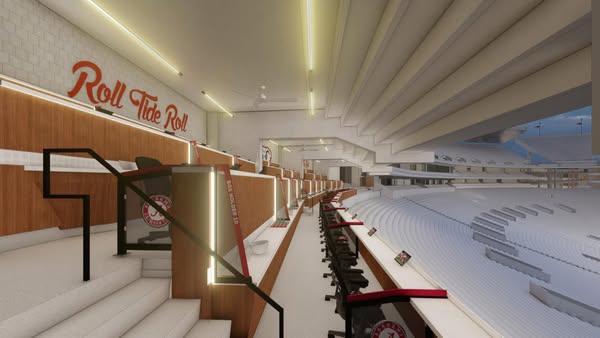In the ever-evolving world of college football, where tradition and modernity are constantly negotiating for relevance and dominance, few programs command attention the way the Alabama Crimson Tide do. In a stunning announcement that sent shockwaves through the college sports landscape, the University of Alabama has unveiled plans for a massive \$2.5 billion renovation of the legendary Bryant-Denny Stadium in Tuscaloosa. Not only is this the most ambitious stadium renovation project in college football history, but it may very well redefine what is expected of an elite college football program in the 21st century. This is not merely a cosmetic upgrade or a facilities enhancement—it is a bold, visionary leap into the future of sports infrastructure, fan experience, athlete development, and university branding. With this move, Alabama is making a statement: the standard is no longer what it used to be. The standard is now Alabama.
Bryant-Denny Stadium, named after legendary coach Paul “Bear” Bryant and former university president George Denny, has long stood as a monument to the dominance and prestige of Alabama football. With a seating capacity that places it among the largest stadiums in the country and a history that spans over a century, the stadium has seen generations of Crimson Tide greatness. Yet even a cathedral of football like Bryant-Denny cannot remain stagnant in an era defined by innovation and spectacle. What Alabama has now undertaken is nothing short of revolutionary. From high-tech advancements to unprecedented luxury offerings, from athlete performance optimization to immersive fan engagement, the \$2.5 billion transformation signals a strategic pivot not just for the university, but for all of college football.
First and foremost, this renovation is rooted in an understanding that the fan experience is evolving. The days when fans were content with metal bleachers and obstructed views are long gone. Today’s fan expects more—more comfort, more access, more technology, and more entertainment. Alabama’s redesign will feature restructured seating with enhanced sightlines, ergonomic chairback options throughout much of the stadium, and a climate-controlled environment in key sections to combat the sweltering Alabama heat. Wi-Fi 6 connectivity, state-of-the-art video boards, augmented reality features, and a Crimson Tide app integration for real-time stats, replays, and concessions ordering will turn the game day experience into an interactive, personalized digital journey.
But the fan-facing upgrades only tell part of the story. Equally important is the commitment to athlete development, health, and performance. The new Bryant-Denny Stadium will include an underground tunnel connecting the locker rooms to a cutting-edge recovery and sports science center. This facility will include cryotherapy chambers, biometric data monitoring, hyperbaric recovery rooms, and one of the largest in-stadium training facilities in the world. This isn’t just about giving players a competitive edge—it’s about investing in their holistic development as athletes and people. Alabama, under the leadership of Athletic Director Greg Byrne and head coach Kalen DeBoer, understands that elite performance begins with elite preparation. This renovation guarantees that every Crimson Tide athlete walks into a facility on par with or even exceeding those found in the NFL.
Perhaps most impressive—and certainly most polarizing—is the incorporation of luxury amenities and revenue-generating suites that rival the most exclusive offerings in professional sports. The top levels of the stadium will now feature multi-tiered luxury boxes, executive sky suites, and high-end dining lounges. One such innovation, the “Tide Club,” will offer patrons not just a game ticket, but an all-inclusive experience complete with private chefs, mixologists, personalized concierge services, and access to post-game press conferences. Critics will undoubtedly argue that such extravagance is a sign of the commercialization of amateur sports. But Alabama sees it differently: this is about reinvesting in excellence. Revenue from these luxury offerings will fund not only the stadium itself but also athletic scholarships, academic support services, and Title IX initiatives, ensuring a holistic impact on the university community.
A particularly forward-thinking component of the renovation is its sustainability plan. Alabama is taking aggressive steps to make Bryant-Denny the greenest stadium in college football. Solar panel installations, water recycling systems, composting initiatives, and energy-efficient lighting will help reduce the stadium’s carbon footprint. Moreover, the University of Alabama is working with environmental science departments and sustainability experts to use the stadium as a living classroom—an evolving experiment in how major public venues can mitigate environmental impact. For students, this presents not just a better game day, but a hands-on educational opportunity with real-world implications.
Another dimension of the renovation that deserves recognition is the way in which the university is leveraging the stadium to benefit the broader Tuscaloosa community. Alabama has pledged to work with local vendors, minority-owned businesses, and in-state contractors throughout the renovation process. Community engagement efforts include ticket subsidies for local schools, a designated “Hometown Heroes” section honoring Alabama public service workers, and a new visitors’ center that will tell the story of Tuscaloosa’s intersection with college football history. In this way, Bryant-Denny is not just being reimagined as a sports venue, but as a communal institution that serves the entire state.
One cannot overstate the symbolism of this renovation in the larger context of college football. For decades, Alabama has been a benchmark of excellence—first under Bear Bryant, and then more recently under Nick Saban. With Saban’s retirement marking the end of an era, some wondered whether Alabama would retain its elite status or retreat into the shadows of its own past. This renovation is a definitive answer to those doubts. It is a public declaration that Alabama is not looking back—it is sprinting toward the future. It also raises the bar for every other program that hopes to compete at the highest level. If you want to match Alabama’s recruiting power, national reach, and championship pedigree, you’re now going to have to compete with an institution that has literally rebuilt the foundation of its program from the ground up.
This move also reflects the shifting economics of college sports. The NCAA landscape is evolving rapidly with the advent of NIL (Name, Image, and Likeness), conference realignment, expanded playoff formats, and increasing athlete empowerment. Schools that fail to adapt will be left behind. Alabama is not merely adapting—it’s proactively leading. By creating an environment that is both player-friendly and commercially lucrative, the university is securing its future relevance. Prospective recruits will no longer just be comparing facilities—they’ll be comparing experiences, exposure, and opportunity. With its new stadium, Alabama offers a platform unmatched in scope or ambition.
Critics might argue that a \$2.5 billion price tag is excessive, particularly in a state with educational funding challenges and income disparities. But university officials have countered this by pointing out that the vast majority of funding is coming from private donors, sponsorships, and athletic revenues. Moreover, they argue that investments of this scale create economic ripple effects—jobs, tourism, local business growth—that benefit the wider community. In short, Alabama is making a bet: that excellence is not a cost, but an asset.
It is also worth examining how this renovation might influence the future of stadium design across the country. Already, programs like LSU, Georgia, and Michigan are rumored to be evaluating their own facility plans in response. Architects and athletic directors from across the nation will undoubtedly descend upon Tuscaloosa in the coming years, studying Alabama’s model as a blueprint for their own endeavors. Much like Oregon revolutionized the concept of branding and facility aesthetics in the early 2000s, Alabama may now be the leader in stadium functionality and multi-purpose innovation. Whether it’s through the incorporation of esports lounges, athlete housing within stadium walls, or AI-assisted training simulations, what begins at Bryant-Denny may eventually become the new normal.
For students and alumni, the emotional impact of the renovation cannot be ignored. Bryant-Denny Stadium is more than concrete and steel—it is a sacred space where memories are forged and legends are born. The challenge for the architects and planners has been to honor the stadium’s hallowed history while thrusting it into the future. Early renderings suggest that this balance has been achieved. The Walk of Champions, the players’ tunnel, and the iconic exterior façade will be preserved, maintaining a visual and emotional continuity that links generations of fans. But inside, it will be a different world—a world where tradition and innovation shake hands.
The timeline for completion is aggressive but calculated. Phase one, which includes structural reinforcements and technological infrastructure, is already underway and expected to conclude by the end of the 2026 season. Subsequent phases will be strategically timed to avoid disrupting home games, with the final ribbon-cutting ceremony anticipated in 2029. University leaders are confident that the logistical complexity will be worth the wait, and early feedback from fans, alumni, and athletes has been overwhelmingly positive.
In the end, what Alabama has undertaken is not just a stadium renovation. It is a philosophical statement about what college athletics can and should be. It challenges the status quo, invites scrutiny, and demands excellence. It recognizes that the future is coming—fast—and that waiting to react is not an option. With this \$2.5 billion investment, Alabama is doing what it has always done best: leading.
Bryant-Denny Stadium will soon be more than a venue. It will be a landmark of aspiration, a symbol of forward-thinking leadership, and a case study in how to balance commercial viability with community impact and student-athlete well-being. Other programs may try to follow, but as always, Alabama is setting the pace. And as the rest of the college football world scrambles to keep up, one thing becomes clearer than ever: the standard is no longer just about winning championships. The standard is about how you build the foundation to win them—again, and again, and again.
For Alabama, that foundation now includes glass towers, digital walls, and recovery rooms—but it still echoes with the roar of the Crimson Tide.



